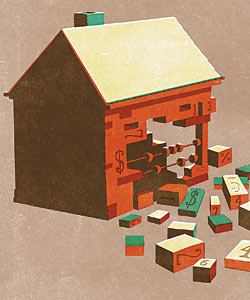
Just when you thought mortgage rates could go no lower, they sank lower still. In late January, according to data from Freddie Mac, 30-year fixed-rate loans had dropped to about 4 percent. Meanwhile, the average 15-year fixed rate was hovering around an even more mouthwatering 3.2 percent.
Which means that even if you’ve already refinanced your mortgage once to capture the benefits of falling rates, it may make sense to do so again. Your savings can be substantial. For example, someone with a $200,000 30-year mortgage at 4 percent would pay about $43,000 less in interest over the life of the loan than someone with the same mortgage at 5 percent.
But the decision is more complicated than you might think. The old rule was that if the difference between the rate on your existing loan and current rates was one percentage point or more, it paid to refinance (providing you had no plans to move). According to several mortgage experts in the Chicago area, now you’ve got to grapple with some new realities to make the call—and to get a good deal.
Factor in higher fees. Unexpected payments can sometimes chip away at any potential savings, warns Jim Rubel, a vice president at 1st Advantage Mortgage in Northfield. For instance, when lenders issue a new loan, most will require you to pay for private mortgage insurance (PMI) if the equity in your home is below 20 percent. With housing prices still down considerably, you may find that refinancing triggers the need for PMI (its cost depends on your credit score and the amount of your equity). To determine whether your upfront and PMI expenses would undermine any refinancing savings, go to hsh.com/calculators.html.
Take a look at HARP. The federal government’s Home Affordable Refinance Program gives advantageous refi terms, such as no requirement for PMI even if your equity is less than 20 percent. The program applies to house and condo mortgages dated May 2009 or earlier, as long as the loan is owned or guaranteed by Fannie Mae or Freddie Mac. And beginning this month, owners of condos in buildings where more than 20 percent of residents have fallen behind on their assessments are now eligible (originally they could not participate). “That should be helpful in places like the West Loop with a lot of [boom years] condos,” says Ray Cohen, a loan officer for Prospect Mortgage in River North. For more information, go to makinghomeaffordable.gov.
Size up your credit. Just because you see an enticing rate advertised doesn’t mean that you will get it. In the wake of the housing bust, lenders are giving their best rates to people who have excellent credit scores—typically 740 or above. If your score is even a little lower, you will probably be charged more, which can add thousands of dollars to your costs over time. To learn your credit score, as well as tips on how to improve it, go to myfico.com (cost: $20, and worth it).
Shoot for a shorter term. If you’re already several years into a 30-year loan, for example, refinancing to another 30-year extends the time before you are debt-free—not a great idea. Refinance to a 15-year instead and you will save $77,000 in interest on a $200,000 loan versus a comparable 30-year. The snag, of course, is that your monthly payments will rise—from $954 to $1,479 in our example. Not up for that? Consider a 20-year loan instead, suggests Cohen: You will get a better rate than a 30-year and a less punishing payment than a 15-year. Alternatively, think about a so-called cash-in refi, suggests Colleen Bara at Chase bank in Chicago. That simply means kicking in enough money during the refinance process to make the monthly payments of a shorter-term loan more affordable. You are essentially prepaying a portion of the mortgage—which, given the lackluster prospects for other investments, can wind up being a pretty good deal.
Illustration: Daniel Stolle



